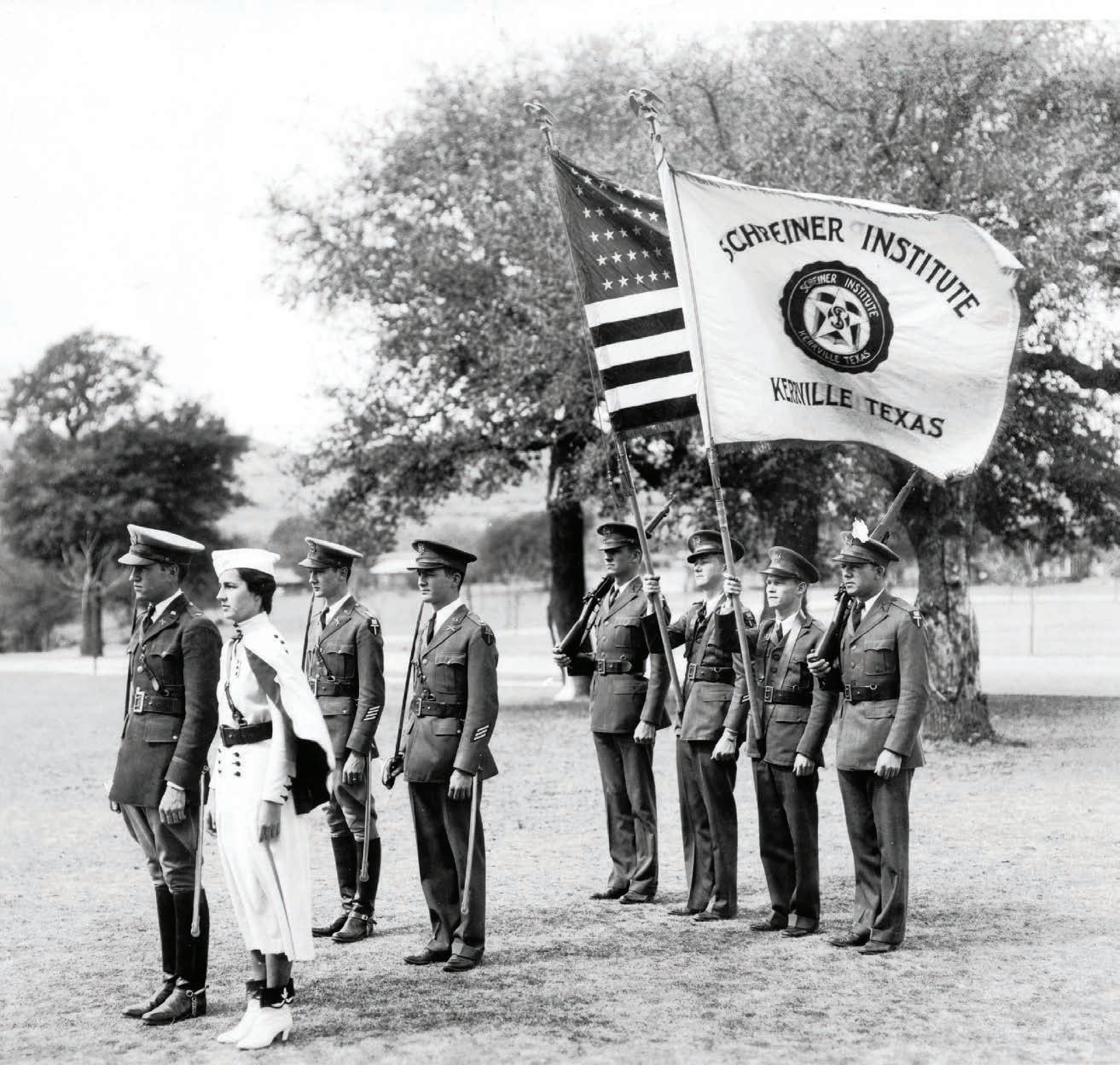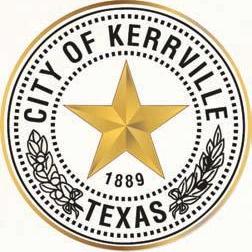
13 minute read
Schreiner Institute: Military Programs & Veteran Affairs
When Schreiner Institute was founded in 1923, its goal was to provide formal education to the young men of the Texas Hill Country which was enhanced with military-style training. While it was not the intended purpose of Schreiner Institute to prepare students to enter the military, due to the events that unfolded in the 1940’s many of these young men later went on to serve in the military during World War II. Schreiner eventually dropped the military-style training and focused more on academia, later becoming a two-year college and then eventually a University.
Today, Schreiner Institute serves as a program on campus whose purpose is serving active duty military members, veterans, and those who are interested in eventually serving in the military as commissioned officers after either completing an ROTC program or attending a service academy.
Advertisement
Every year there are thousands of young men and women who pledge to serve in our nation’s military knowing that with such a pledge they will sacrifice many of the freedoms that we hold dear as American citizens. For some, this pledge is made out of a necessity to provide for their family. For others, it is an opportunity to serve a cause much greater than themselves, and for others, it is an opportunity to show their patriotism. Some of these young men and women will go on to have illustrious careers in the military, but the vast majority will transition out of the military after a number of years looking to gain higher levels of education to better prepare themselves when entering the workforce.
As the Director of Schreiner Institute, I can speak on behalf of my experiences before, during, and after serving in the military. While growing up I had the opportunity to spend a lot of time with my grandfather who served in the United States Navy during World War II. Throughout these times together my grandfather would often tell me of his many experiences during his time in the Navy. While he would also share stories about his life growing up in San Antonio during the Great Depression, I can distinctly remember thinking that in many ways his time in the Navy was what shaped him to be the man I knew him to be some 50 years later in life.
After graduating high school, I knew that I wanted to serve in some capacity and that I wanted to do so in a manner that was much larger than myself. I also knew that I would not be opposed to serving in the military so I went to the local recruiter’s office and began talking about what such a commitment would look like. A little less than a year later I was on a plane headed to boot camp in San Diego, California. Throughout my years in the Marine Corps, I learned many lessons about life and about serving a cause much greater than the self.
After transitioning out of the active-duty component of the Marine Corps, I began going to college full-time. This was the point that I began to understand just how much serving in the military had shaped my life. I also quickly began to realize that students transitioning out of the military face a unique set of challenges that are oftentimes not understood by those who have not made a similar transition.
For some, there are impacts on their family life that must be considered and dealt with. Others have to balance work, school, and family commitments. Throughout your time in the military, you are taught to pay close attention to detail, to obey instructions, and to show up where you are supposed to be when you are supposed to be there. These are all skills that when applied make for a very successful transition from the military to college or the workforce.
While most – if not all – veterans are equipped with the skills necessary to be successful in college, there are pieces involved that many veterans may not know much about and that is where Schreiner Institute provides services to bridge the gap. It is our mission to provide customized services for every active duty or veteran student on campus to best fit their needs and to ensure they are successful both on campus and off.
Under the title Schreiner Institute, we are also excited to share that in the fall of 2020, our Air Force ROTC will be a part of Detachment 842, through a cross-town agreement with The University of Texas at San Antonio. This agreement provides students at Schreiner University the opportunity to participate in one of the largest and most successful Air Force ROTC programs in the nation while also having a personalized education provided by one of the best private universities in Texas. Detachment 842 earned the prestigious national Right of Line Best Large Detachment award in 2009 and 2014. Shannon Deville
Director of Schreiner Institute

Upon graduation from Schreiner University, a student who successfully completes ROTC will receive a commission as a second lieutenant in the United States Air Force. During the first two years of the program, cadets are allowed to take military leadership courses and participate in military training without contractual obligations. Over the course of four years, ROTC students at Schreiner will have the chance to live and learn on a beautiful college campus—located in the picturesque Hill Country of Texas— where they will form lifelong bonds with fellow cadets.
While ROTC is one option for those interested in becoming commissioned officers, Schreiner Institute will also have a Service Academy Preparatory program aimed at preparing students who are interested in attending a service academy but are not quite ready. This program will aim to develop a student’s academics, time management skills, and character through intentional programming and coaching.
The mission of Schreiner University is “to prepare students for meaningful work and purposeful lives in a changing global society.” Schreiner Institute is directly contributing to this effort by better preparing students for success both while at Schreiner, and after.
Town & Gown A Pact With The City

Together achieving more
Schreiner University is blessed to be in a community where the relationship between the City of Kerrville and University is symbiotic. In the summer of 2019, Kerrville’s Mayor, Bill Blackburn, along with Schreiner University President, Dr. Charlie McCormick, formed a Town and Gown compact between the two organizations. Town and Gown is nothing new, as you will see later the term goes back to the Middle Ages. However, these compacts are generally formed because of some type of rift between the two. Our Town and Gown is much different. Ours is more of an agreement to create a formal taskforce to plan and work together in the best interests of the City, University and community as a whole. Each month, the City and University bring equal representation to the table to discuss pressing issues, projects and ways in which we can support each other for the benefit of all.
“Town and Gown” was a term originally established identifying the two By Toby Appleton, Marketing & Communications Manager distinct communities found in a “college town.” “Town” is referring to the local community and government while “gown” refers to the university and its students and faculty.
In the Middle Ages, academics commonly dressed in long robes. These later evolved into the academic long black gown worn along with a hood – what we would now recognize as academic regalia. The gown was comfortable and warm for the scholars studying in the often cold, unheated academic buildings. While it was traditional attire in most of the universities, the gown also served as a social symbol, with gowns only being worn by scholars, clergy and judges. The scholar’s hood was often adorned with the colors showing their university affiliation. With their clothing so distinctive and different, the scholars were distinguished and different from the citizens of the town. In this separation, the phrase "Town and Gown" is said to have been born.
Conflict was very much the norm in the medieval towns that shared space with a university – attended by scholars from different regions of Europe. These were shared areas with two groups of people with different cultures, beliefs and loyalties. Even beyond their cultural differences, universities were led by priests during this time, and the scholars saw themselves as being above “civil law.” All of this led to common violence among the citizens and scholars. Oxford University and local residents fought on such a consistent basis that another university was formed at Cambridge to attempt to separate them.
Later, while the relations had generally improved between Town and Gown, conflicts and violence were still evident. In the early 1900’s, incidents involving Yale students and the citizens of New Haven, Connecticut, show many examples of the uneasy Town and Gown relations. The separation and divide between Town and Gown were exhibited in the 1950’s when the Yale Daily News wrote: "Yale is like a glittering showgirl in a roadside diner. Her beauty and expensive clothes overshadow the fact that New Haven, to its yearround inhabitants, at least, is a mill town. Its citizens are mainly factory workers who take home factory workers' wages. This is the basic cause of strife." From full-scale riots to mobs threatening to burn down the college ensued. There was a conflict that escalated out of control to such an extent that the military had to to keep the peace when citizens aimed two militia cannons at the college. Fortunately, they were stopped before the cannons could be fired. The infamous “Snowball Riot” of 1959 even caught national attention when Yale students began attacking New Haven police officers during a parade on St. Patrick’s Day that year. The Harvard Crimson newspaper even reported: "For two centuries, Yale and New Haven have periodically come together in gory frays."
As colleges commonly became more pronounced brick and mortar facilities, American colleges - often located in small towns - housed students in dormitories on campus. The lines that defined the two communities were clearly drawn, but as students began to venture off-campus for housing the distinction became less clear.
After World War II, more and more students were beginning to live



off-campus. With the GI Bill, the returning veterans had the financial means to pursue college degrees. Most were older than other students and many had families to support. This was a catalyst for offcampus student housing. The students, who lived in the community, became better integrated in the community, and the cities began to better accommodate the universities. This helped ease the tensions between Town and Gown tremendously.
The relationships shared by universities and the communities has been both positive and negative all through history. Universities can often benefit from the communities surrounding them, while at other times, urban developments can undermine the stability of the universities. Likewise, universities can provide cultural life to the city, but – in a negative relationship – can also undermine the urban culture.
Since the 1980s, formal Town and Gown compacts began popping up in U.S. cities near large universities to try to work through the issues each were having. However, the integration of some campus and community areas has not been without problems. University populations can generate traffic and parking problems in towns and especially in adjacent neighborhoods. Certain industries requiring highly educated workers may be drawn to college communities. The growth of these work sectors, and additional upwardly mobile residents, may increase the competition for space and potentially drive up land costs. These perpetual factors often cause continuing tensions between Town and Gown, but here, Schreiner University and the City of Kerrville continue to work together for the betterment of the two.
Schreiner University and the City of Kerrville’s Town and Gown compact has led to the exchange of ideas and unprecedented support for each other. By working together, both allow for the rapid exchange of knowledge, expertise and people resulting in both entities benefiting. In this way, the City of Kerrville benefits from Schreiner University being within its borders, and Schreiner benefits from having a City and community so willing to work together for a common goal. Schreiner University is, again, truly blessed to be in this symbiotic relationship.





“Schreiner University provides an outstanding collegiate experience and education for approximately 1,400 students each year. The University has been an integral part of the Kerrville community since its founding in 1923, and currently generates more than $65 million of economic impact in the region. Schreiner’s students are a vital part of the local community, be it through their patronage of local businesses or their many hours of volunteer service with a variety of local organizations. ” – Kerrville Mayor Bill Blackburn Bill Blackburn Mayor of Kerrville “The Town-Gown Compact allows the City and Schreiner to collaborate on matters of mutual interests, which include strengthening our quality of life through educational, cultural and economic opportunities. ” – Kerrville City Manager Mark McDaniel . . . . . . . . . . . . . . . . . .
Mark McDaniel Kerrville City Manager




The City of Kerrville and local businesses continue showing their visible support for Schreiner University and its students. In a tremendously successful initiative with the Kerrville business community to show this support for Schreiner students through the “Kerrville Loves Schreiner University Students” campaign, support has never been more visible. There are currently 194 Kerrville businesses proudly displaying their support for our students.
When the business owner agrees to display the decal at their business, Schreiner University Marketing then, in turn, advertises the business to the campus community. This has led to increased business and opportunities for our students in the way of internships and jobs.
The goal of the “Kerrville Loves Schreiner Students” campaign is ultimately to help foster a welcoming environment and a visible sense of appreciation for the Schreiner students in our community, and also to attract them and their families to stay in Kerrville, shop in our businesses and eat in our restaurants.
The Kerrville 2050 Comprehensive Plan identifies the fostering of higher education and entrepreneurship as community assets. Creating the right environment for a “college town district” is a clear objective. Schreiner University’s 2023 Strategic Plan addresses a physical and highly visible presence in the community, and Schreiner fostering deeper connections to our community. The “Kerrville Loves Schreiner Students” initiative helps to accomplish both of these initiatives. With Schreiner University having a physical and visible presence in the community, we hope this generates interest in the community to want to come take part in the campus and experience all it has to offer. Just as Tivy High School is much thought of as Kerrville’s hometown high school, Schreiner University is Kerrville’s hometown University. Kerrville Loves Schreiner Students Campaign
Continuing Support for Schreiner Students and Kerrville Businesses












